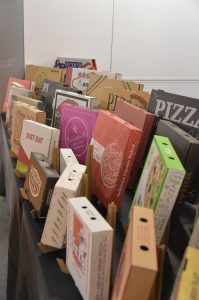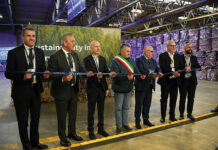As the international tradeshow pioneering all the sustainable packaging and intralogistics solutions, ALL4PACK Emballage Paris is a source of inspiration to support the sector’s players in the face of current and future challenges. In this perspective, the tradeshow stands out by deciphering market developments and regulations, also highlighting the most responsible innovations. In a move to remain close to the concerns of the sector, ALL4PACK Emballage Paris conducted a survey* ahead of its 2022 show (21-24 November, Paris Nord Villepinte) among the exhibition’s community (packaging suppliers and user industries) to gauge its vision of the future of packaging materials.
 THE ISSUE OF MORE ENVIRONMENTALLY FRIENDLY PACKAGING
THE ISSUE OF MORE ENVIRONMENTALLY FRIENDLY PACKAGING
The packaging revolution is underway
- Everyone in the ALL4PACK Emballage Paris community is aware of the need for a green transition: 88% consider it to be a priority to use more environmentally friendly packaging.
- The main reasons driving this transition are consumer expectations (69%), benefits in terms of brand image (56%) and changes in legislation (49%).
- Conversely, the obstacles expressed are, unsurprisingly, the cost of use of environmentally friendly materials (63%) followed further behind by the availability (43%) and the quality of materials (37%), obstacles more prevalent among user industries (43%) than among suppliers (27%).
 TYPES OF MATERIALS USED
TYPES OF MATERIALS USED
Diversity enhanced by the emergence of new materials:
Paper-cardboard (77%) and plastic (73%) remain the main materials used for packaging. Biomaterials are as yet little used (18%).
Nevertheless, when asked about the type of materials used in the coming two years, the ALL4PACK community appears to have a clear vision (only 0.5% of those surveyed responded “Don’t know”).
- The use of biomaterials should increase: 37% of respondents said that they wanted to start using biomaterials in the coming two years.
- Paper and cardboard should also rise significantly: 46% of decision-makers declare they wanted to use more of it.
- A real decline in the use of plastic is expected to occur: 32% are intending to reduce their use of this resource, nonetheless, few plan to stop using it altogether (5%). The use of metal, glass and wood should remain relatively unchanged.
 Packaging suppliers/user industries
Packaging suppliers/user industries
THE SHARED VISION OF THE MEMBERS OF THE ALL4PACK COMMUNITY
The issue of more responsible packaging
- User industries are virtually unanimous on the importance of using more environmentally friendly packaging materials: 88% of them see this issue as a priority.
- More than 50% of packaging suppliers believe that it is a major priority to use more environmentally friendly materials. French suppliers appear to be leading the way on the subject (100% see this issue as either a priority among others or a major priority).
Explanations and motives
- For user industries, consumer expectations (69%) are the primary reason leading to the use of more environmentally friendly materials, in particular in the food industry (83%). The benefits in terms of image (56%), regulatory changes (49%) and senior management wishes (35%) are the next most-cited reasons, in particular in large companies.
- On the supply side, the same three reasons top the podium, but with different results: at 71%, consumer expectations are the leading reason to adopt more environmentally friendly packaging materials.
 Regulatory and legal changes arrive in second place (57%), followed by benefits in terms of image (55%). A great many French respondents consider that the issue of more environmentally friendly packaging material is a priority (average of 74% on the three first items).
Regulatory and legal changes arrive in second place (57%), followed by benefits in terms of image (55%). A great many French respondents consider that the issue of more environmentally friendly packaging material is a priority (average of 74% on the three first items).
Obstacles
- For user industries, the main obstacles to using more environmentally friendly packaging materials is clearly cost (66%), in particular in France (71%). To a lesser extent, availability (43%) and quality of materials (43%) also appear problematic for many companies.
- For suppliers, while the cost of materials is also the main obstacle to using more environmentally friendly packaging materials (57%), followed by the availability of materials (41%), the investment required to use these materials is the third most cited obstacle (29%), in particular for companies with 50 employees or more (40.5%).
 Materials used
Materials used
- For user industries, biomaterials are currently relatively little-used (14.8%). Paper/cardboard (86%) and plastic (75.8%) remain the norm. Glass is today particularly used in the food industry (34.7%).
- On the supply side, there is a still quite low number of producers of packaging made from biomaterials (22.9%), compared with suppliers of plastic packaging (69.9%) and paper/cardboard packaging (62.7%).
Materials of the future
 In the next two years, many user industries expect to reduce the use of plastic (34%) but the material is still unlikely to disappear: 74% of them still expect to use it. The use of biomaterials should in parallel see a strong increase (39% expect to start using them), and that of paper-cardboard should also rise (48% expect to use more). With the exception of plastic, all packaging materials are on the increase in the food sector.
In the next two years, many user industries expect to reduce the use of plastic (34%) but the material is still unlikely to disappear: 74% of them still expect to use it. The use of biomaterials should in parallel see a strong increase (39% expect to start using them), and that of paper-cardboard should also rise (48% expect to use more). With the exception of plastic, all packaging materials are on the increase in the food sector.- Among the survey respondents, the number of producers of packaging made from biomaterials is still quite low compared with suppliers of plastic and paper-cardboard packaging. A large number of packaging users expect to reduce their use of plastic (28%) but few will stop using it altogether (3.6%). The use of biomaterials should logically increase (56.6%,), just like the use of paper-cardboard should increase (66.3%) to meet the expectations of user industries. The supply of biomaterials should increase more in the food market, with 64% expecting to use this material in the coming two years (compared with 24% who use it currently).
The full findings of the survey can be found on the website www.all4pack.fr/






















